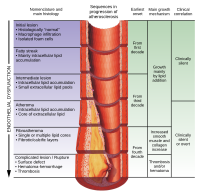
Photo from wikipedia
Pediatric venous thromboembolism (VTE) is increasing in incidence but minimal data exist for best practices regarding therapy, use of thrombophilia testing, and management of long-term complications. Classification schema use anatomic… Click to show full abstract
Pediatric venous thromboembolism (VTE) is increasing in incidence but minimal data exist for best practices regarding therapy, use of thrombophilia testing, and management of long-term complications. Classification schema use anatomic location and presence of clinical or thrombophilic inciting factors. There are a small number of risk-assessment and risk-modeling systems for incident VTE, but all suffer from low numbers, single-institution design, and lack of prospective validation. Acute treatment is limited to heparin products and thrombolysis may be indicated in specific situations. In addition, chronic postthrombotic comorbidities are expected to increase in incidence and lack evidence-based treatment paradigms.
Journal Title: Hematology/oncology clinics of North America
Year Published: 2019
Link to full text (if available)
Share on Social Media: Sign Up to like & get
recommendations!